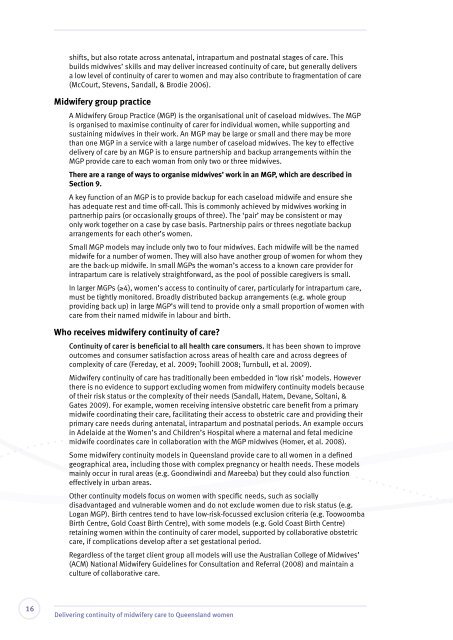Delivering continuity of midwifery care to Queensland women
Delivering continuity of midwifery care to Queensland women
Delivering continuity of midwifery care to Queensland women
You also want an ePaper? Increase the reach of your titles
YUMPU automatically turns print PDFs into web optimized ePapers that Google loves.
shifts, but also rotate across antenatal, intrapartum and postnatal stages <strong>of</strong> <strong>care</strong>. This<br />
builds midwives’ skills and may deliver increased <strong>continuity</strong> <strong>of</strong> <strong>care</strong>, but generally delivers<br />
a low level <strong>of</strong> <strong>continuity</strong> <strong>of</strong> <strong>care</strong>r <strong>to</strong> <strong>women</strong> and may also contribute <strong>to</strong> fragmentation <strong>of</strong> <strong>care</strong><br />
(McCourt, Stevens, Sandall, & Brodie 2006).<br />
Midwifery group practice<br />
A Midwifery Group Practice (MGP) is the organisational unit <strong>of</strong> caseload midwives. The MGP<br />
is organised <strong>to</strong> maximise <strong>continuity</strong> <strong>of</strong> <strong>care</strong>r for individual <strong>women</strong>, while supporting and<br />
sustaining midwives in their work. An MGP may be large or small and there may be more<br />
than one MGP in a service with a large number <strong>of</strong> caseload midwives. The key <strong>to</strong> effective<br />
delivery <strong>of</strong> <strong>care</strong> by an MGP is <strong>to</strong> ensure partnership and backup arrangements within the<br />
MGP provide <strong>care</strong> <strong>to</strong> each woman from only two or three midwives.<br />
There are a range <strong>of</strong> ways <strong>to</strong> organise midwives’ work in an MGP, which are described in<br />
Section 9.<br />
A key function <strong>of</strong> an MGP is <strong>to</strong> provide backup for each caseload midwife and ensure she<br />
has adequate rest and time <strong>of</strong>f-call. This is commonly achieved by midwives working in<br />
partnerhip pairs (or occasionally groups <strong>of</strong> three). The ‘pair’ may be consistent or may<br />
only work <strong>to</strong>gether on a case by case basis. Partnership pairs or threes negotiate backup<br />
arrangements for each other’s <strong>women</strong>.<br />
Small MGP models may include only two <strong>to</strong> four midwives. Each midwife will be the named<br />
midwife for a number <strong>of</strong> <strong>women</strong>. They will also have another group <strong>of</strong> <strong>women</strong> for whom they<br />
are the back-up midwife. In small MGPs the woman’s access <strong>to</strong> a known <strong>care</strong> provider for<br />
intrapartum <strong>care</strong> is relatively straightforward, as the pool <strong>of</strong> possible <strong>care</strong>givers is small.<br />
In larger MGPs (≥4), <strong>women</strong>’s access <strong>to</strong> <strong>continuity</strong> <strong>of</strong> <strong>care</strong>r, particularly for intrapartum <strong>care</strong>,<br />
must be tightly moni<strong>to</strong>red. Broadly distributed backup arrangements (e.g. whole group<br />
providing back up) in large MGP’s will tend <strong>to</strong> provide only a small proportion <strong>of</strong> <strong>women</strong> with<br />
<strong>care</strong> from their named midwife in labour and birth.<br />
Who receives <strong>midwifery</strong> <strong>continuity</strong> <strong>of</strong> <strong>care</strong><br />
Continuity <strong>of</strong> <strong>care</strong>r is beneficial <strong>to</strong> all health <strong>care</strong> consumers. It has been shown <strong>to</strong> improve<br />
outcomes and consumer satisfaction across areas <strong>of</strong> health <strong>care</strong> and across degrees <strong>of</strong><br />
complexity <strong>of</strong> <strong>care</strong> (Fereday, et al. 2009; Toohill 2008; Turnbull, et al. 2009).<br />
Midwifery <strong>continuity</strong> <strong>of</strong> <strong>care</strong> has traditionally been embedded in ‘low risk’ models. However<br />
there is no evidence <strong>to</strong> support excluding <strong>women</strong> from <strong>midwifery</strong> <strong>continuity</strong> models because<br />
<strong>of</strong> their risk status or the complexity <strong>of</strong> their needs (Sandall, Hatem, Devane, Soltani, &<br />
Gates 2009). For example, <strong>women</strong> receiving intensive obstetric <strong>care</strong> benefit from a primary<br />
midwife coordinating their <strong>care</strong>, facilitating their access <strong>to</strong> obstetric <strong>care</strong> and providing their<br />
primary <strong>care</strong> needs during antenatal, intrapartum and postnatal periods. An example occurs<br />
in Adelaide at the Women’s and Children’s Hospital where a maternal and fetal medicine<br />
midwife coordinates <strong>care</strong> in collaboration with the MGP midwives (Homer, et al. 2008).<br />
Some <strong>midwifery</strong> <strong>continuity</strong> models in <strong>Queensland</strong> provide <strong>care</strong> <strong>to</strong> all <strong>women</strong> in a defined<br />
geographical area, including those with complex pregnancy or health needs. These models<br />
mainly occur in rural areas (e.g. Goondiwindi and Mareeba) but they could also function<br />
effectively in urban areas.<br />
Other <strong>continuity</strong> models focus on <strong>women</strong> with specific needs, such as socially<br />
disadvantaged and vulnerable <strong>women</strong> and do not exclude <strong>women</strong> due <strong>to</strong> risk status (e.g.<br />
Logan MGP). Birth centres tend <strong>to</strong> have low-risk-focussed exclusion criteria (e.g. Toowoomba<br />
Birth Centre, Gold Coast Birth Centre), with some models (e.g. Gold Coast Birth Centre)<br />
retaining <strong>women</strong> within the <strong>continuity</strong> <strong>of</strong> <strong>care</strong>r model, supported by collaborative obstetric<br />
<strong>care</strong>, if complications develop after a set gestational period.<br />
Regardless <strong>of</strong> the target client group all models will use the Australian College <strong>of</strong> Midwives’<br />
(ACM) National Midwifery Guidelines for Consultation and Referral (2008) and maintain a<br />
culture <strong>of</strong> collaborative <strong>care</strong>.<br />
16<br />
<strong>Delivering</strong> <strong>continuity</strong> <strong>of</strong> <strong>midwifery</strong> <strong>care</strong> <strong>to</strong> <strong>Queensland</strong> <strong>women</strong>
















